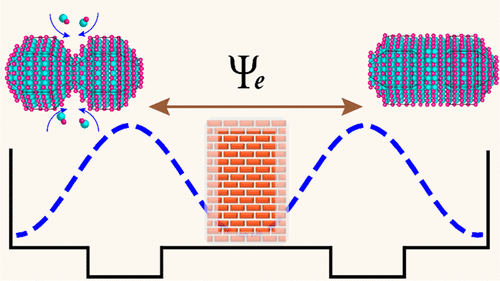当前位置:
X-MOL 学术
›
J. Am. Chem. Soc.
›
论文详情
Our official English website, www.x-mol.net, welcomes your feedback! (Note: you will need to create a separate account there.)
Neck Barrier Engineering in Quantum Dot Dimer Molecules via Intraparticle Ripening
Journal of the American Chemical Society ( IF 15.0 ) Pub Date : 2021-11-18 , DOI: 10.1021/jacs.1c08863 Jiabin Cui 1, 2 , Somnath Koley 1, 2 , Yossef E Panfil 1, 2 , Adar Levi 1, 2 , Yonatan Ossia 1, 2 , Nir Waiskopf 1, 2 , Sergei Remennik 2 , Meirav Oded 1, 2 , Uri Banin 1, 2
Journal of the American Chemical Society ( IF 15.0 ) Pub Date : 2021-11-18 , DOI: 10.1021/jacs.1c08863 Jiabin Cui 1, 2 , Somnath Koley 1, 2 , Yossef E Panfil 1, 2 , Adar Levi 1, 2 , Yonatan Ossia 1, 2 , Nir Waiskopf 1, 2 , Sergei Remennik 2 , Meirav Oded 1, 2 , Uri Banin 1, 2
Affiliation

|
Coupled colloidal quantum dot (CQD) dimers represent a new class of artificial molecules composed of fused core/shell semiconductor nanocrystals. The electronic coupling and wave function hybridization are enabled by the formation of an epitaxial connection with a coherent lattice between the shells of the two neighboring quantum dots where the shell material and its dimensions dictate the quantum barrier characteristics for the charge carriers. Herein we introduce a colloidal approach to control the neck formation at the interface between the two CQDs in such artificial molecular constructs. This allows the tailoring of the neck barrier in prelinked homodimers formed via fusion of multifaceted wurtzite CdSe/CdS CQDs. The effects of reaction time, temperature, and excess ligands are studied. The neck filling process follows an intraparticle ripening mechanism at relatively mild reaction conditions while avoiding interparticle ripening. The degree of surface ligand passivation plays a key role in activating the surface atom diffusion to the neck region. The degree of neck filling strongly depends also on the initial relative orientation of the two CQDs, where homonymous plane attachment allows for facile neck growth, unlike the case of heteronymous plane attachment. Upon neck filling, the observed red-shift of the absorption and fluorescence measured both for ensemble and single dimers is assigned to enhanced hybridization of the confined wave function in CQD dimer molecules, as supported by quantum calculations. The fine-tuning of the particle interface introduced herein provides therefore a powerful tool to further control the extent of hybridization and coupling in CQD molecules.
中文翻译:

通过粒子内成熟在量子点二聚体分子中进行颈垒工程
耦合胶体量子点 (CQD) 二聚体代表了一类由融合的核/壳半导体纳米晶体组成的新型人工分子。电子耦合和波函数杂化是通过在两个相邻量子点的壳之间形成具有相干晶格的外延连接来实现的,其中壳材料及其尺寸决定了电荷载流子的量子势垒特性。在这里,我们介绍了一种胶体方法来控制这种人工分子结构中两个 CQD 之间界面处的颈部形成。这允许在通过多面纤锌矿 CdSe/CdS CQD 融合形成的预连接同源二聚体中定制颈部屏障。研究了反应时间、温度和过量配体的影响。颈部填充过程在相对温和的反应条件下遵循颗粒内成熟机制,同时避免颗粒间成熟。表面配体钝化程度在激活表面原子扩散到颈部区域中起关键作用。颈部填充的程度还很大程度上取决于两个 CQD 的初始相对方向,其中同名平面附着允许轻松的颈部生长,这与异名平面附着的情况不同。在颈部填充时,观察到的对整体和单个二聚体的吸收和荧光测量的红移归因于 CQD 二聚体分子中受限波函数的增强杂交,这得到了量子计算的支持。
更新日期:2021-12-01
中文翻译:

通过粒子内成熟在量子点二聚体分子中进行颈垒工程
耦合胶体量子点 (CQD) 二聚体代表了一类由融合的核/壳半导体纳米晶体组成的新型人工分子。电子耦合和波函数杂化是通过在两个相邻量子点的壳之间形成具有相干晶格的外延连接来实现的,其中壳材料及其尺寸决定了电荷载流子的量子势垒特性。在这里,我们介绍了一种胶体方法来控制这种人工分子结构中两个 CQD 之间界面处的颈部形成。这允许在通过多面纤锌矿 CdSe/CdS CQD 融合形成的预连接同源二聚体中定制颈部屏障。研究了反应时间、温度和过量配体的影响。颈部填充过程在相对温和的反应条件下遵循颗粒内成熟机制,同时避免颗粒间成熟。表面配体钝化程度在激活表面原子扩散到颈部区域中起关键作用。颈部填充的程度还很大程度上取决于两个 CQD 的初始相对方向,其中同名平面附着允许轻松的颈部生长,这与异名平面附着的情况不同。在颈部填充时,观察到的对整体和单个二聚体的吸收和荧光测量的红移归因于 CQD 二聚体分子中受限波函数的增强杂交,这得到了量子计算的支持。


























 京公网安备 11010802027423号
京公网安备 11010802027423号